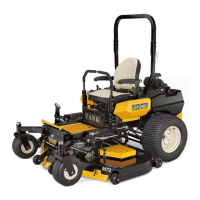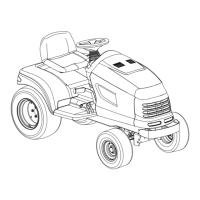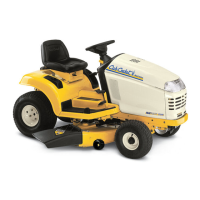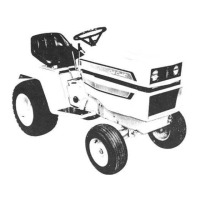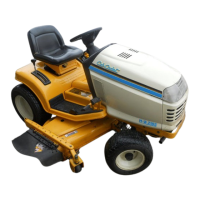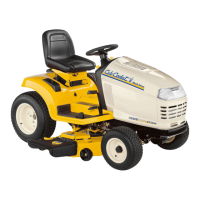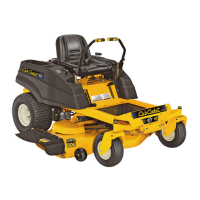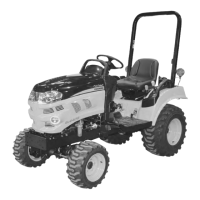6 se c t i O n 2 — iM p O r t a n t sa f e Op e r a t i O n pr a c t i c e s
lines, guy wires, and buildings, could create hazardous
conditions whereby the machine could experience a tip-
over or roll-over. The canopy can provide protection for
the operator from some environmental exposure (sunlight,
rain, etc.). Work lights may be available.
6.
and should not be tampered with, modified in any manner,
or removed.
7.
and therefore the operator must be aware of potential
doorways, clothes lines, utility wires, etc., that could cause
the machine to upset or rollover. Use caution in (or avoid)
structures, trees, etc.
8.
caution when operating on slopes.
basis for damage and improper operation. Replace all
components that are damaged or are not functioning
properly with authorized replacement parts.
Fail ure to use the seat belt properly could result in serious
injury or death if an accidental overturn occurs. In order
fastened around the operator at all times when the
an overturn could cause serious injury or death.
overs.
machine.
Hydraulic Devices and Systems
draulic fluid escaping under pressure may have sufficient force
to penetrate skin and to cause serious injury. If foreign fluid is
injected into the skin, it must be surgically removed within a few
hours by a doctor familiar with this form of injury, or gangrene
may result.
WARNING: Keep body and hands away from
pinholes or nozzles that could eject hydraulic fluid
under high pressure. Use paper or cardboard, not
hands, to search for leaks!
e all pressure in the system before performing any
work on the system, and make sure that:
The key is removed
The engine spark plug wire(s) removed
All connections to the negative terminal of the battery are
removed
The park brake is set
All by-pass valves, if so equipped, are open
lic controls are actuated to release pressure on
pumps, cylinders, etc. If “float” positions are available, they
should be used.
After the above operations are completed, it should be safe to
begin disconnecting the lines or components. It is still a good
idea to cover the connection with a cloth shield and then gently
loosen connections.
WARNING: Make sure all hydraulic fluid
connections are tight and all hydraulic hoses and
lines are in good condition before applying pressure
to the system.
Service
Safe Handling of Gasoline:
To av oid personal injury or property damage use extreme
care in handling gasoline. Gasoline is extremely
flammable and the vapors are explosive.
personal injury can occur when gasoline is spilled on
yourself or your clothes which can ignite. Wash your skin
and change clothes immediately.
Use only an approved gasoline container.a.
To prevent static discharge, never fill containers b.
inside a vehicle or on a truck or trailer bed with a
plastic liner. Always place containers on the ground
away from your vehicle before filling.
When practical, remove gas-powered equipment c.
from the truck or trailer and refuel it on the ground.
If this is not possible, then refuel such equipment on
a trailer with a portable container, rather than from a
gasoline dispenser nozzle.
To avoid static discharge, keep the nozzle in contact d.
with the rim of the fuel tank or container opening
at all times until fueling is complete. Do not use a
nozzle lock-open device.
Extinguish all cigarettes, cigars, pipes and other e.
sources of ignition.
Never fuel machine indoors f. near an open flame,
spark or pilot light as on a water heater, space heater,
furnace, clothes dryer or other gas appliances.
If the fuelg. container spout will not fit inside the fuel
tank opening, use a funnel.
Never remove gas cap or add fuel while the engine h.
is hot or running. Allow engine to cool at least two
minutes before refueling.
i.
inch below bottom of filler neck to allow space for
fuel expansion.
Replace gasoline cap and tighten securely.j.
If gasoline is spilled, wipe it off the engine and k.
equipment. Move machine to another area. Wait 5
minutes before starting the engine.
To reduce fire hazards, keep machine free of grass, l.
leaves, or other debris build-up. Clean up oil or fuel
spillage and remove any fuel soaked debris.
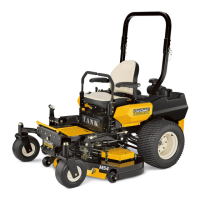
